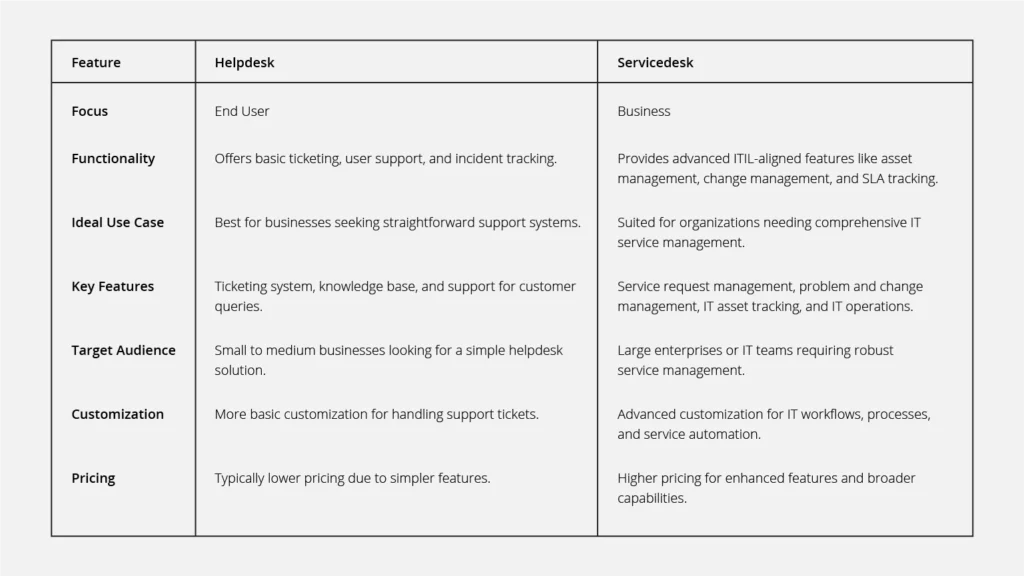Have you ever wondered about the difference between a help desk and a service desk? If you’re thinking they’re the same thing and often used interchangeably, let’s clear up that misconception. While they may seem similar, they are not, and understanding the subtle differences can have a significant impact on your customer service operations.
Many customer service experts confuse service desks with help desks. This common misunderstanding can lead to mismatched support services and unmet expectations.
So, how are they different, and why does it matter for your support team?
In this article, we’ll explore the differences between help desk and service desk software, explaining how each plays a key role in delivering support. We’ll also discuss how these systems promote efficient internal operations and reduce disruptions in distinct ways.
What is a Help Desk?
At its core, a help desk is a specialized team equipped with dedicated software to quickly address technical issues. Whether the customer has forgotten a password, encountered software problems, or experienced hardware glitches, the help desk is the main point of contact for resolving these technical issues.
Now, imagine your computer freezes while you’re working. Who do you call? The help desk.
They’re like the IT Emergency Room of your company, addressing and fixing issues promptly. Help desks have been an important part of businesses since the 1980s, primarily focusing on reactive support. However, like an emergency room, they can sometimes get overwhelmed, leading to delays or less helpful fixes that some users may have encountered.
What is a Service Desk?
A service desk, on the other hand, serves as the primary communication point between a company and its stakeholders—customers, employees, vendors, and partners. The role of the service desk extends beyond fixing immediate technical issues; it also handles broader and ongoing challenges.
Service desk agents don’t just answer calls. They handle queries about products, assist users with updates, and manage services.
Think of a service desk as the receptionist of a large hotel. Just as a receptionist helps guests with check-ins, local recommendations, and resolving issues, service desks provide comprehensive support. They manage everything from routine service requests and new feature installations to maintaining extensive knowledge bases and self-service tools like chatbots. Service desks also monitor their performance through detailed reporting on efficiency and customer satisfaction.
This makes service desks more comprehensive and efficient compared to help desks, which have a more limited scope. Yet, both are crucial in ensuring smooth operations.
Key Differences Between Help Desks and Service Desks

1. Based on the Level of Service
- Help Desk:
The help desk provides quick and simple services. If you encounter a technical glitch, such as a forgotten password or malfunctioning software, the help desk will assist you with a password reset or workaround, allowing you to continue your work swiftly. - Service Desk:
The service desk goes a step further. Got a problem with your computer? They’ll fix it and keep you informed about system updates or changes. If you need software installed, they’ll not only handle the installation but also guide you on how to use it. They’ll even notify you of system updates and guide you through them.
2. Based on Scope
Let’s consider a scenario where a software glitch prevents employees from accessing a crucial database.
- Help Desk:
When this glitch occurs, the help desk is your first point of contact. They will investigate the issue and aim for a quick fix, such as a workaround or resetting the software to resolve the immediate problem. - Service Desk:
The service desk goes beyond resolving the issue. They will investigate what caused the glitch and take steps to prevent it from recurring. They’ll coordinate with IT teams, ensuring that not only you but the entire department doesn’t face the same issue in the future.
3. Based on Skills Required
- Help Desk:
- Technical Know-how: Requires knowledge of common software and hardware issues.
- Communication Skills: Must explain technical terms in simple language.
- Patience and Problem-solving: Requires a calm approach in tricky situations, working through problems step by step.
- Education/Certification: A diploma or associate degree in IT is beneficial. Certifications like CompTIA IT Fundamentals (ITF+) are a plus.
- Service Desk:
- Broader Technical Expertise: Requires in-depth knowledge of IT processes and complex systems.
- Project Management: Manages multiple requests and changes efficiently.
- Interpersonal Skills: Facilitates connections between IT and other departments.
- Education/Certification: A bachelor’s degree in IT is preferred. Certifications like ITIL® Foundation or CompTIA A+ are beneficial.
4. Based on Costs and Maintenance
- Help Desk:
Generally more cost-effective, with expenses mainly covering staffing and basic tools for ticketing and communication. Maintenance costs are typically lower, limited to keeping the help desk software updated and training staff in basic troubleshooting. - Service Desk:
More expensive due to the broader range of services and advanced IT service management software. Ongoing staff training to stay current with evolving IT processes and technologies also adds to maintenance costs.
Final Thoughts
Help desks and service desks play distinct but complementary roles in IT support. Help desks provide quick, reactive solutions, while service desks focus on proactive service management and broader IT functions. Understanding these differences helps companies streamline support operations and enhance overall user satisfaction.


